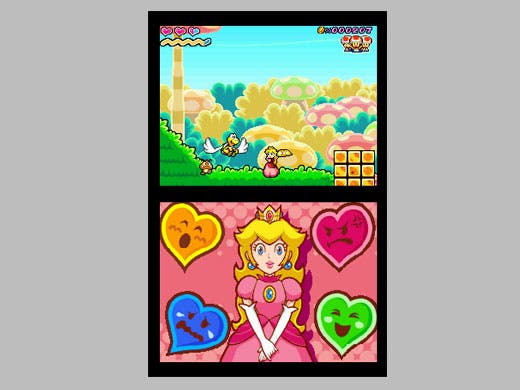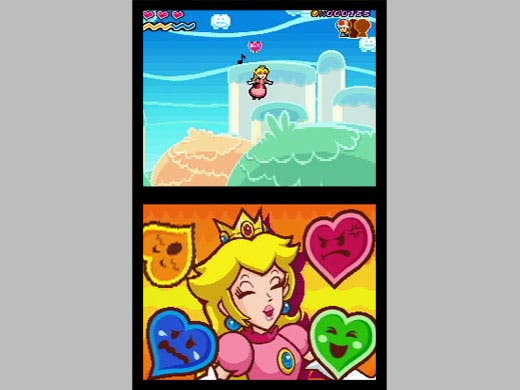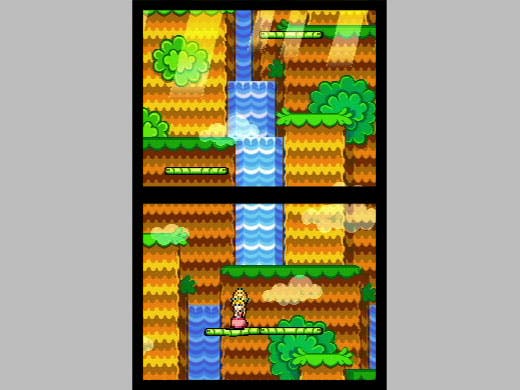Super Princess Peach
Princess Superstar? Or a Mouldy Peach?
Viewed through one lens of the great telescope of personal truth, the Mario series is the shining star of the games industry; a cherished intellectual property that Nintendo isn't afraid to have fun with. As comfortable expanded and re-imagined in the joyful Mario & Luigi titles as it is as disposable family entertainment in Mario Party, the Mario series will always be a vital and magical part of gaming.
Through the other lens, which has dirt on it, the Mario series is a smelly rock of astronaut poop; an intellectual property long past its sell by date, which Nintendo would rather milk endlessly than face up to a desperate need for new ideas. Mario and chums shoehorn themselves into increasingly obscure genres in an attempt to remain relevant, with Mario now well acquainted with everything from soccer balls to baseball bats. With the only fat Italian-American that the average person wants to see swinging a baseball bat being Tony Soprano, the Mario series is increasingly redundant.

Depending on the lens you use to view the stars of Nintendo's night sky, your initial impressions of Super Princess Peach are going to be strongly coloured. A clever and funny twist on the Mario series, with the Princess saving Mario? Or a weak stab at the captive market of female DS owners brought by Nintendogs? You stab girls? SICK!
Though Princess Peach's most recent outings as a controllable character (outside of the Mario sports titles) were in the Paper Mario games, here controlling her brings to mind her role in the NES title Super Mario Bros. 2. There is none of the high pressure instant death action seen in Mario's usual platforming adventures, but a more thoughtful experience with a life bar, the princess's wide range of abilities used to explore levels with a variety of paths and puzzles.
Through the eight stages she must fight through on Vibe Island to rescue Mario, the princess's trials are eased by her 'vibes' - the political-correctness-gone-mad description of Peach's wildly changing womanly emotions. If Mario has to deal with this on a regular basis, I can understand his haste in getting kidnapped for a change (am I right, fellas?).
With a flick of a thumb on the touch screen, Peach feels Joy, allowing her to fly and create cyclones; Rage, allowing her to start fires and stomp switches; Gloom, allowing her to cry uncontrollably (her tears grow sprouts and extinguish fires); and Calm, which I didn't grasp the use for until the final world, but which allows Peach to slowly regain her life bar.

The bottom screen is entirely taken up with a nice picture of Peach staring somewhat vacantly at the player, and the touchable hearts that activate her vibes. This is a terrible waste of the second screen, and rather than aid usability, the touch-screen is a detriment, placing functions that could easily be assigned to buttons (the shoulder buttons, X and Y are underused) on the touch-screen, which is particularly hard to press when you have your hands already occupied.
Keeping my thumbs on the d-pad and buttons, I've found myself twisting my index fingers from their natural positions to stab the screen, making play often uncomfortable and in many cases rendering the vibes ineffectual - with only milliseconds to spare before Peach falls to her death, hitting the Joy heart and then the A button to fly is nearly impossible. Of course, why Peach would feel a sudden rush of joy in the face of instant death is another matter.
As you can tell, this isn't a game for a player obsessed with keeping their touch-screen free of finger smudges. I sincerely doubt anyone, left or right handed, could successfully play this using the stylus.
Noting that I didn't learn of the health regeneration skill until the very end of the game, it's clear that despite input difficulties Super Princess Peach is near soporifically easy. The difficulty curve is a flat line apart from two dreadfully unfair spikes - the first spike aligned to the first boss, frustratingly requiring skilful vibe use as the player still struggles with the unusual input method. This is likely to put off any videogame-phobic little girls or other-halves that may otherwise have been lured into the seedy world of gaming by Princess Peach's nice pink dress, but the worst spike comes with the final boss.

All game designers that see fit to have final bosses with multiple forms or stages, each one harder than the last, already unnecessarily hard to begin with, should be given a sound beating by a progression of angry men, each angrier and stronger than the last. Because that's how hitting a brick wall of difficulty feels. My disdain for this kind of artificial challenge is only succeeded by my disdain for designers who have the player fight every single boss in the game for a second time one after another at the end, which is thankfully not the case here. (Oh, their punishment? To be beaten by perhaps ten or eleven angry men across a couple of weeks, and then beaten again by them all in quick succession a couple of days later. Make the punishment fit the crime, I say.)
Despite all of this doom and gloom, Princess Peach is not by any means a bad game. The more sedate pace of a Super Mario Bros. 2 inspired platformer suits the character, and the game's subplot, featuring Princess Peach's talking umbrella sidekick Perry, is cute, though it does actually endanger Peach's status as the main character in her own game. Exploration of the game world nets jigsaw pieces and musical notes, either usable in a remarkably pointless sound test (featuring the 'Peach Hit Five', a band consisting of only two members) and a jigsaw mini-game, which is as exactly as fun as a playing a jigsaw with a pair of tweezers sounds. However, there are a range of delightful mini-games to be found in the main game, including my personal favourite, which requires you blow into the microphone to make Toad jump enemies.
While the eight worlds on offer are not exactly rich with character (Nintendo must have had some pretty intense brainstorming sessions to come up with a slippy slidey ice world, for example) they are more than entertaining enough to warrant a revisit, with the game offering a secondary, more difficult challenge (including extra levels) for those who complete it once.
Super Princess Peach is not a truly remarkable title on the scale of Mario & Luigi, not only as it's not very funny, but its innovations in interface and design actually make it slightly less fun than it might be if you played it 'straight'. But neither is it a shameless cash-in. The game, though a solely single-player experience, has not only a fun story mode, but a host of extras adding longevity in the face of its relative ease. It's fun for a while, but its star doesn't shine bright enough to be anything but ultimately forgettable.

